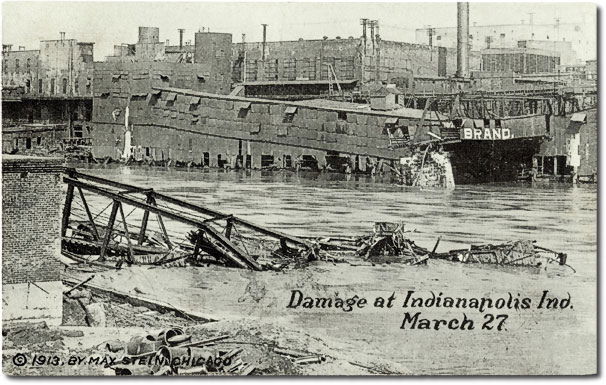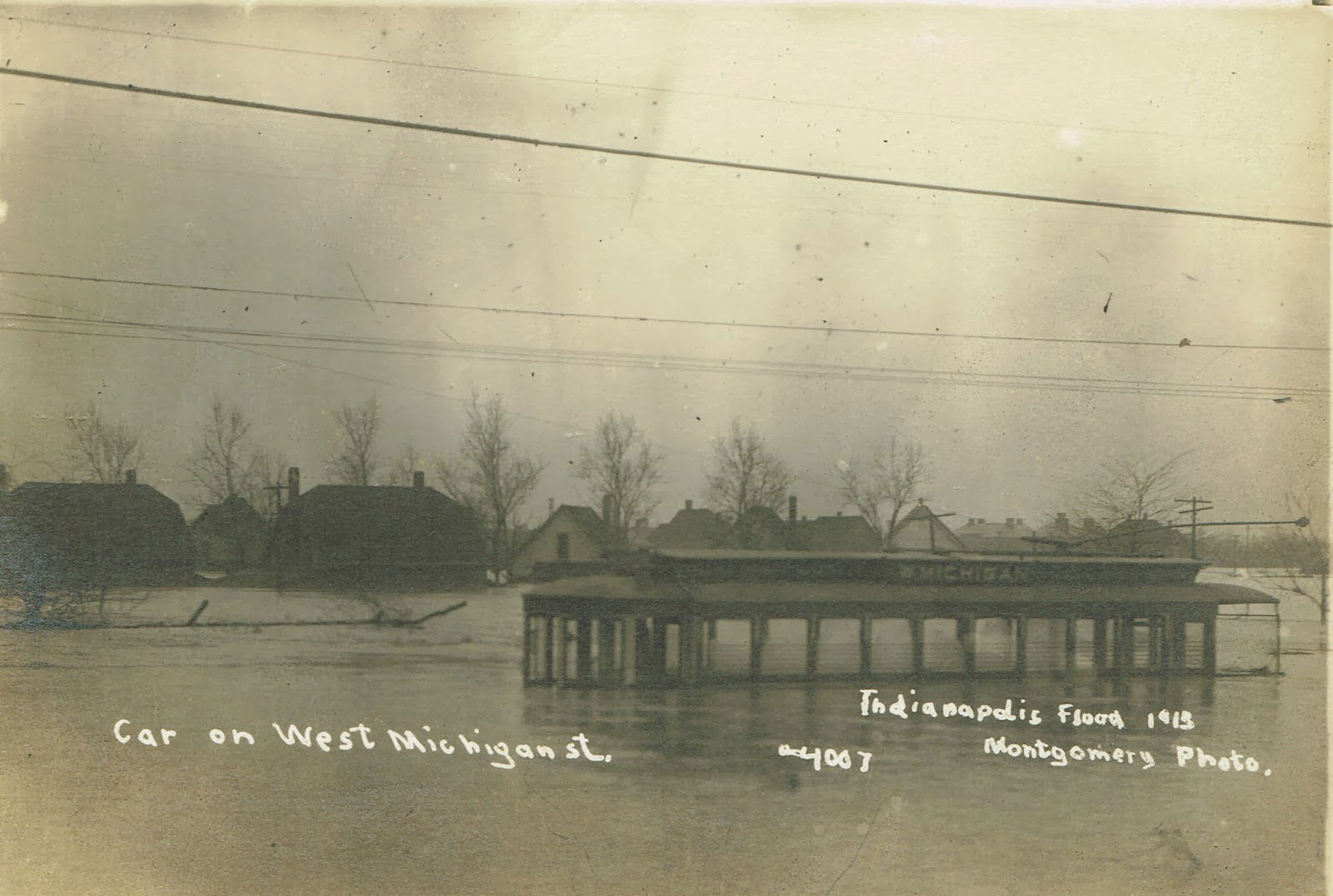Great Indiana Flood

by Mary C. Hill
INDIANAPOLIS, IN
It was Easter Sunday, March 23, a day to rejoice. However, it was anything but for the thousands of Indianapolis residents who woke up that morning. These residents were unknowingly about to become victims of the city's worst natural disaster in its history. This was the Great Flood of 1913.
There would be no Easter egg hunts or family gatherings. Parents would keep their children indoors as torrential rains poured into their neighborhoods. Little did anyone know that the rains would continue for four more harrowing days.
The Great Flood of 1913 occurred between March 23 and March 26. Besides Indiana, Ohio and eleven other states fell to the wrath of the flood. The death toll in these states would be estimated at more than 1,000. Six inches of rain fell on Indianapolis over five days, causing at least 25 known deaths and inundating a 6-square-mile area. More than 7,000 families lost their homes. Indiana's damages would be estimated at $25 million (in 1913 dollars).

West Indianapolis was the hardest-hit area in the city. Residents were forced to leave their homes and find refuge farther away from the White River. One such couple was Charles and Sadie Hill, second-generation Irish Americans. What they witnessed during the five Sadie and Charles Hill's days of carnage was like the wrath of God being sent upon them. The Hills retreated to higher ground. They later settled on West Street, where there was a burgeoning community of Irish Americans.
The first hint of impending doom came on Good Friday, March 21, when a voracious windstorm swept through Indianapolis. On Saturday, dark rain clouds could be seen hovering over the horizon. However, with a modern-day radar and a city radio station, residents were warned of the oncoming storm.
Then came Easter Sunday, when the downpour started. No one was deeply concerned since the residents weren't notified of the danger ahead.
The heavy rains spilled over into Monday, causing White River, Fall Creek, and Eagle Creek to overflow. Earthen levees gave way, causing surrounding streets to be inundated by torrents of water.
The Washington Street bridge, the main artery between the West Side and Indianapolis, collapsed by floodwaters 19.5 ft. above flood stage. This severed any connection between the two areas. Due to railroad and telephone line damage caused by the collapse, Indianapolis was cut off from the rest of the world.

On Tuesday, Indianapolis' water service was shut down when floodwaters breached the Indianapolis Water Company's pumping station. The Indianapolis Brewing Company allowed residents to draw "pure water" from its 15 on-site wells.
The Morris Street levee broke on Tuesday, forcing onlookers of the rising river to flee for safety. Rescuers combed the night searching for missing persons whose cries for help were impeded by the sound of the oncoming water.
On Wednesday, White River reached its crest. Its height was estimated at 311⁄2 feet — more than 19 feet above flood stage. The powerhouse at the Indianapolis Street Car Company was flooded, terminating streetcar service to the city. Fall Creek flooded up to 13th Street, washing out Fall Creek Boulevard. Near-north-side residents were forced to flee from their homes. The Meridian, College, and Northwestern bridges were wiped out, leaving Capital Avenue as the only way to the suburbs in the north.

Water began to rise to the steps leading into homes in the 3200-3300 blocks of Broadway, College, and Park. Residents who did not flee from their homes tried building a makeshift dike. However, the residents of Broadway became enraged when the floodwaters were redirected to their Street. Before anyone knew, the earthen levee gave way, and the whole neighborhood became submerged in the turbulent waters.
More than half of Broad Ripple was the next area to go underwater. Residents built up the canal locks with sandbags and other materials to prevent the rest of the town from being flooded. The water had risen more than 12 feet above the dam.
The Vandalia Railroad Bridge collapsed into the rushing water below as the flooding continued on Thursday. Ten train cars carrying coal had been placed on the bridge to protect it from the rising water. However, the turbulent waters were no match for it. Unfortunately, there were several residents on the bridge at the same time. When the bridge collapsed, the onlookers plummeted into the icy waters. First responders spent the night searching for the residents, but their efforts were thwarted by the sound of the raging waters drowning out the victims' cries for help.

Raging White River
Friday brought relief from the flooding as the rains finally stopped. The Indianapolis Water Company was back in operation, restoring water services to residents who had been denied it by the flooding.When the waters started to recede, reports of people looting reached the office of the Governor. He immediately dispatched the National Guard, ordering it to shoot any looter on sight.
Post-flood problems also included weather hazards. The temperature was now low 20s, and a harsh wind blew throughout the city. Many residents were stranded in their homes, which were without heat. The long road of rebuilding their lives and ruined homes was just the beginning for the thousands of flood victims.
Many lessons were learned from the devastation of The Great Flood, which led to the federal government lending support for comprehensive flood prevention and funding for flood control projects. In 1941, the Governor of Ohio signed The Ohio Conservancy Act. The act allowed for the establishment of conservancy districts with the authority to implement flood control projects. Soon, other states adopted it as a model to be adopted.